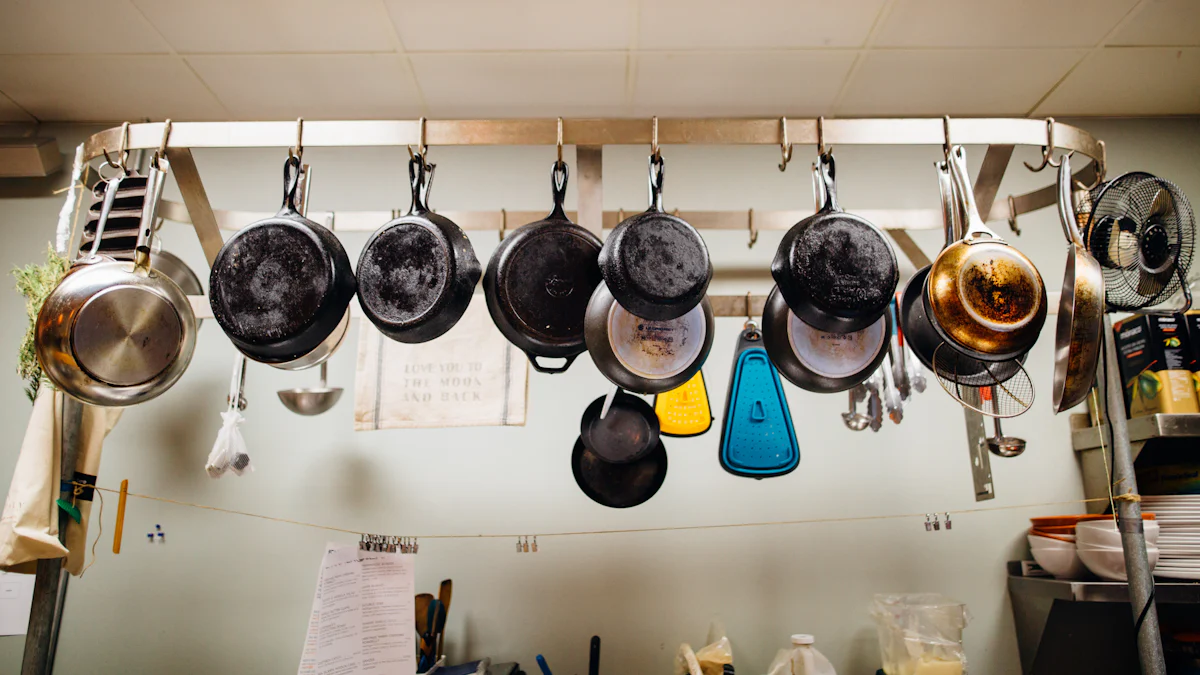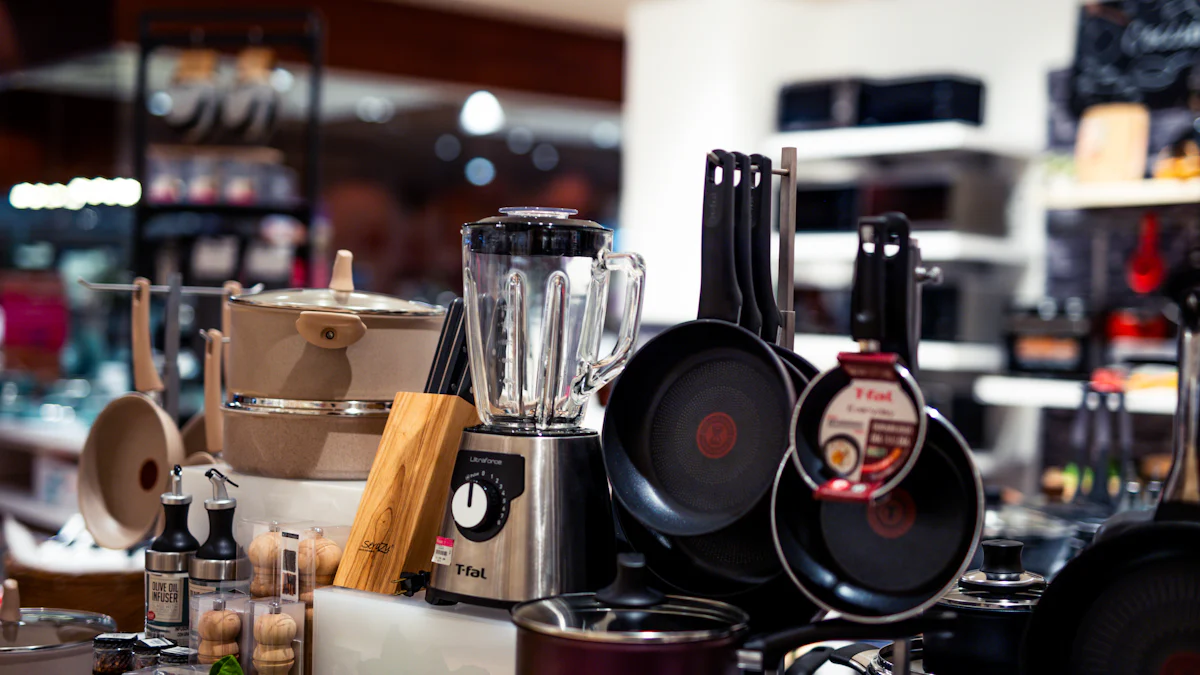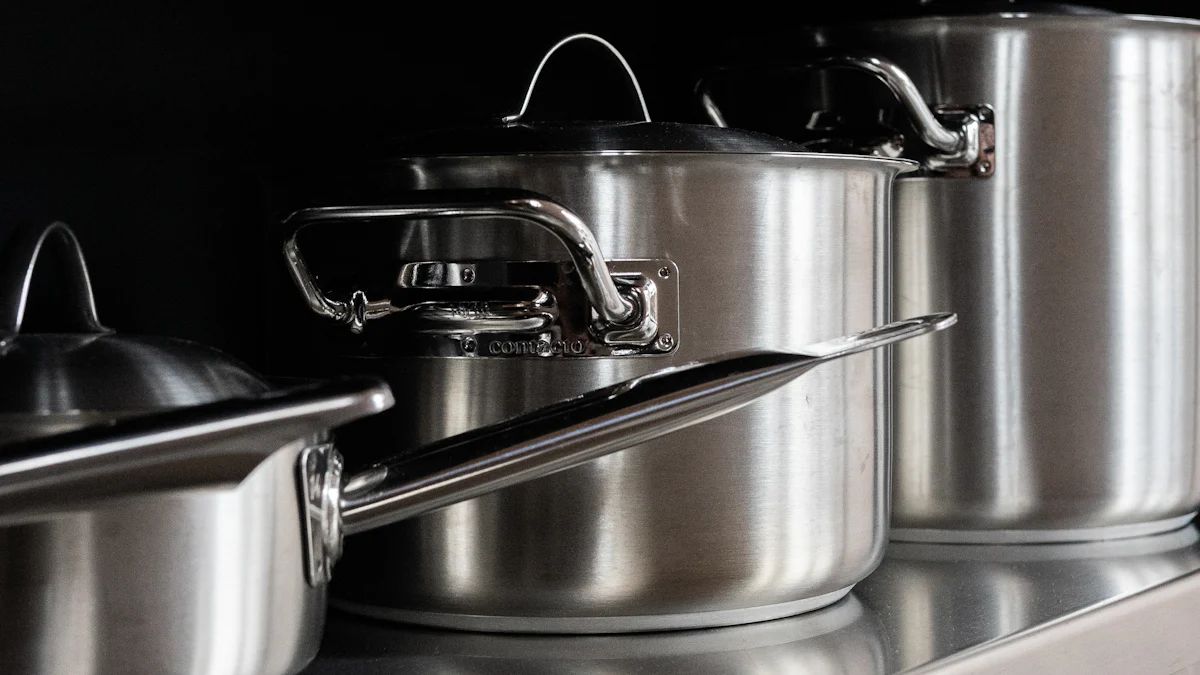
I have always found it fascinating how cookware spare parts manufacturers are strategically positioned across the globe. These manufacturers, located in regions like Asia, North America, and Europe, drive the cookware industry by supplying essential components. Handles, lids, and spouts are just a few examples of the parts they produce. Their locations often reflect regional strengths, such as cost efficiency, advanced technology, or sustainable practices. This global distribution ensures that manufacturers meet the diverse needs of consumers and businesses alike.
Key Takeaways
- Cookware spare parts makers are mainly in Asia, North America, and Europe.
- China makes cheap products, while South Korea creates high-quality, innovative ones.
- North America and Europe focus on eco-friendly methods for green products.
- Being close to buyers lowers shipping costs and speeds up delivery.
- Knowing each region’s strengths helps people choose the right products.
Major Hubs for Cookware Spare Parts Manufacturers

Asia
China’s dominance in affordable and large-scale production
China leads the world in cookware spare parts manufacturing. Its ability to produce high-quality components at affordable prices sets it apart. I have observed how manufacturers here leverage economies of scale to meet global demand. Many factories specialize in producing items like silicone glass lids and detachable handles. Their focus on cost efficiency ensures competitive pricing without compromising quality.
South Korea’s focus on innovation and premium quality
South Korea stands out for its innovative approach to cookware spare parts. Manufacturers here prioritize advanced technology and premium materials. I admire their commitment to creating durable and user-friendly products. For instance, tempered glass lids with silicone edges are a popular choice due to their reliability and heat resistance. South Korean companies often lead in developing eco-friendly solutions, which aligns with global sustainability goals.
India’s emergence as a cost-effective manufacturing hub
India has become a rising star in the cookware spare parts industry. Its manufacturers offer a balance of affordability and quality. I have noticed how Indian companies excel in producing universal pan lids and pressure cooker parts. Their focus on space-saving designs and easy-to-clean features appeals to modern consumers. India’s growing reputation as a cost-effective hub makes it an attractive option for businesses worldwide.
North America
The United States’ emphasis on high-quality and sustainable production
The United States takes pride in its high standards for cookware spare parts. Manufacturers here emphasize sustainability and ethical sourcing. I find their use of food-grade materials and compliance with international standards impressive. Products like flat pan lids often feature innovative designs that enhance functionality. American companies also prioritize durability, ensuring long-lasting performance.
Mexico’s role in nearshoring and cost-efficient manufacturing
Mexico plays a key role in nearshoring for North American markets. Its proximity to the United States reduces shipping costs and delivery times. I have seen how Mexican manufacturers focus on cost-efficient production while maintaining quality. Their expertise in producing aluminum cookware and detachable handles supports regional demand. This strategic location benefits both businesses and consumers.
Europe
Germany’s precision engineering and advanced technology
Germany excels in precision engineering for cookware spare parts. Manufacturers here use advanced technology to create reliable and efficient products. I admire their attention to detail, especially in items like induction disks and kettle spouts. German companies often set benchmarks for quality and innovation in the industry.
Italy’s craftsmanship and design expertise
Italy combines craftsmanship with design expertise in cookware spare parts. I have always appreciated their focus on aesthetics and functionality. Italian manufacturers produce elegant yet practical items, such as silicone saucepan lids. Their dedication to quality ensures products that are both durable and visually appealing.
Eastern Europe’s growing manufacturing capabilities
Eastern Europe is emerging as a competitive region for cookware spare parts manufacturing. Countries like Poland and Hungary are gaining recognition for their skilled labor and cost-effective production. I have noticed how manufacturers here focus on meeting international standards. Their growing capabilities make them valuable players in the global market.
Factors Influencing the Location of Cookware Spare Parts Manufacturers
Cost Efficiency
The impact of labor costs and raw material availability
Labor costs and raw material availability significantly influence where cookware spare parts manufacturers establish their operations. Regions with lower labor costs, such as India and Eastern Europe, attract manufacturers seeking cost-effective production. Access to abundant raw materials, like aluminum or silicone, further reduces expenses. I have observed how this combination allows manufacturers to produce high-quality components at competitive prices. For instance, the use of recycled aluminum in cookware production not only cuts costs but also supports sustainability efforts.
Regional advantages in production costs
Each region offers unique advantages in production costs. Asian countries, particularly China, excel in large-scale manufacturing due to their established supply chains and infrastructure. North America, on the other hand, benefits from nearshoring practices, with Mexico providing cost-efficient solutions for U.S. markets. These regional strengths enable manufacturers to optimize their operations and meet global demand effectively.
Quality and Expertise
How skilled labor and technology affect product quality
Skilled labor and advanced technology play a crucial role in determining product quality. Countries like Germany and South Korea lead the way in precision engineering and innovation. I admire how their manufacturers utilize cutting-edge technology to create durable and reliable products, such as tempered glass lids with silicone edges. Skilled workers ensure that every component meets stringent quality standards, enhancing the reputation of these regions.
Regional compliance with international standards
Compliance with international standards is essential for cookware spare parts manufacturers. Regions like North America and Europe prioritize adherence to safety and quality regulations. I have noticed how this focus ensures that products, such as universal pan lids, meet consumer expectations. Manufacturers in these regions often invest in certifications to demonstrate their commitment to excellence.
Sustainability and Environmental Practices
Eco-friendly manufacturing in North America and Europe
Sustainability has become a key factor in the cookware industry. Manufacturers in North America and Europe adopt eco-friendly practices to appeal to environmentally conscious consumers. I find it inspiring how companies use recycled materials, such as aluminum, to create “green alloys” for cookware. This innovation reduces waste and promotes resource conservation. Other practices include natural coatings and water-based dyes, which further enhance sustainability.
| Practice | Description |
|---|---|
| Recycled Materials | Introduction of recycled aluminum pots and pans as a significant innovation. |
| Natural Coatings | Use of coatings with natural elements, such as water or dye-free options. |
Government regulations shaping sustainable practices
Government policies also drive sustainable manufacturing. Regulations in Europe and North America encourage the use of eco-friendly materials and processes. I have seen how these rules push manufacturers to innovate and adopt greener practices. This not only benefits the environment but also strengthens their market position by aligning with consumer values.
Proximity to Markets
Reducing shipping costs and delivery times
I have always noticed how proximity to markets plays a critical role in reducing shipping costs and delivery times. Manufacturers strategically position their facilities near major consumer hubs to streamline logistics. For example, cookware spare parts manufacturers in Mexico benefit from their close proximity to the United States. This location allows them to deliver products faster while minimizing transportation expenses.
Shorter shipping distances also reduce the risk of delays caused by customs or unforeseen disruptions. I find this particularly important for businesses that rely on just-in-time inventory systems. By sourcing components from nearby regions, companies can maintain steady production schedules and avoid costly downtime. Additionally, reduced shipping distances contribute to lower carbon emissions, aligning with the growing demand for sustainable practices.
Meeting regional demand for cookware spare parts
Meeting regional demand is another advantage of being close to key markets. Manufacturers can quickly adapt to local preferences and trends. For instance, in North America, I have observed a strong preference for universal pan lids and flat pan lids that are easy to clean and store. Manufacturers in this region cater to these needs by designing products that combine functionality with convenience.
In Europe, the demand for eco-friendly cookware spare parts has surged. Manufacturers here focus on creating items like silicone saucepan lids made from food-grade materials. These products not only meet environmental standards but also appeal to consumers who prioritize sustainability.
Proximity to markets also enables manufacturers to provide better after-sales support. I have seen how companies with local operations can respond to customer inquiries and service requests more efficiently. This responsiveness enhances customer satisfaction and builds long-term loyalty.
Notable Cookware Spare Parts Manufacturers Around the World

Leading Manufacturers in Asia
Examples like Ningbo Xianghai Kitchenware Co., Ltd.
I have always admired the contributions of Asian manufacturers to the global cookware industry. Xianghai Kitchenware stands out as a leading cookware spare parts manufacturer in China. Their expertise lies in producing high-quality components such as silicone glass lids and detachable handles. I find their focus on innovation and cost efficiency remarkable. They utilize advanced production techniques to create durable products that meet international standards. Their ability to balance affordability with quality makes them a preferred choice for businesses worldwide.
Prominent North American Manufacturers
Companies like Vollrath and 360 Cookware
North America boasts some of the most reputable cookware spare parts manufacturers. Vollrath, based in the United States, has earned a reputation for producing premium-quality components. I appreciate their commitment to sustainability and the use of food-grade materials. Their flat pan lids, known for their durability and user-friendly designs, are a favorite among consumers.
360 Cookware, another prominent name, specializes in eco-friendly manufacturing. Their products often feature innovative designs that enhance functionality while reducing environmental impact. I admire how these companies prioritize both quality and sustainability, setting benchmarks for the industry.
European Leaders in the Industry
Notable manufacturers like Kuhn Rikon in Switzerland
Europe is home to some of the most skilled manufacturers in the cookware industry. Kuhn Rikon, based in Switzerland, exemplifies precision and craftsmanship. Their silicone saucepan lids, designed with tempered glass and food-grade silicone, are both durable and visually appealing. I find their attention to detail and focus on user-friendly features impressive.
German manufacturers also excel in creating reliable products like induction disks and kettle spouts. Their use of advanced technology ensures consistent quality. Italy, known for its design expertise, produces cookware spare parts that combine elegance with practicality. These European leaders continue to set high standards in the global market.
Emerging Players in Other Regions
Manufacturers in South America and Africa
I have noticed a significant rise in cookware spare parts manufacturing in South America and Africa. These regions are emerging as promising players in the global market due to rapid urbanization and economic growth. Manufacturers here are tapping into the growing middle class, which drives demand for household goods, including cookware accessories. This shift has created opportunities for businesses to cater to a new wave of consumers seeking quality and affordability.
In South America, countries like Brazil and Argentina are leading the charge. I admire how manufacturers in these nations focus on producing cost-effective yet durable components. Many companies are adopting sustainable practices, such as using recycled materials for aluminum cookware and universal pan lids. This approach aligns with the increasing consumer preference for eco-friendly products. I find it fascinating how these manufacturers balance affordability with environmental responsibility.
Africa, on the other hand, is making strides in innovation. I have observed a growing interest in smart cookware accessories with digital features. These products appeal to tech-savvy consumers who value convenience and efficiency. For instance, manufacturers in South Africa are experimenting with smart lids that monitor cooking temperatures and prevent overflows. This innovation reflects the region’s potential to compete on a global scale.
Key trends shaping these markets include:
- Rapid urbanization and rising disposable incomes.
- A growing middle class driving demand for household goods.
- Increasing consumer preference for eco-friendly and sustainable products.
- Popularity of smart cookware accessories with digital features.
I believe these developments position South America and Africa as emerging hubs for cookware spare parts manufacturing. Their focus on innovation, sustainability, and affordability ensures they remain competitive in the evolving global market.
Implications of Manufacturer Locations for Consumers and Businesses
Product Quality and Durability
How location impacts the performance of cookware spare parts
I have observed that the location of a cookware spare parts manufacturer directly influences the quality and durability of its products. Regions like Germany and South Korea, known for their advanced technology and skilled labor, consistently produce high-performance components. For example, silicone saucepan lids from these areas often feature tempered glass and food-grade silicone, ensuring reliability and heat resistance.
On the other hand, manufacturers in cost-effective regions like India focus on balancing affordability with quality. Their universal pan lids combine functionality with durability, making them a practical choice for consumers. I believe that understanding the strengths of each region helps businesses and consumers make informed decisions about the products they choose.
Cost and Accessibility
Pricing variations based on manufacturing regions
Pricing for cookware spare parts varies significantly depending on the manufacturing region. I have noticed that Asian countries, particularly China and India, offer competitive pricing due to lower labor costs and efficient supply chains. This affordability makes their products accessible to a broader audience.
In contrast, manufacturers in North America and Europe prioritize sustainability and advanced engineering, which often results in higher prices. For instance, flat pan lids from these regions may cost more but offer superior quality and eco-friendly features. I find that businesses must weigh these pricing differences against their target market’s preferences and budget constraints.
Sustainability and Ethical Sourcing
Choosing manufacturers with eco-friendly practices
Sustainability has become a critical factor in choosing a cookware spare parts manufacturer. I have seen how companies adopting eco-friendly practices gain favor among consumers. Leading manufacturers now use recycled materials, such as aluminum, to create durable and environmentally conscious products. Profilglass, for instance, demonstrates this commitment by utilizing post-consumer waste in its cookware components.
This shift towards sustainability reflects the growing demand for resource conservation and waste reduction. I believe that selecting manufacturers who prioritize these practices not only benefits the environment but also aligns with modern consumer values. Products like silicone glass lids, made with natural coatings and recycled materials, showcase how innovation and sustainability can coexist.
Cookware spare parts manufacturers are strategically located in Asia, North America, and Europe, each region showcasing unique strengths. Asia leads with cost-effective production, while North America emphasizes sustainability and quality. Europe excels in craftsmanship and aesthetics. I have observed how factors like cost efficiency, quality standards, and proximity to markets shape these locations. Future trends, such as nearshoring and eco-friendly practices, will redefine the industry. Consumers increasingly value sustainable products, with recycled aluminum and innovative designs gaining popularity. These shifts ensure the cookware spare parts manufacturer remains pivotal in meeting global demand.
FAQ
What are the most common cookware spare parts?
Handles, lids, spouts, and induction disks are the most common spare parts. I’ve noticed that universal pan lids and silicone glass lids are especially popular due to their versatility and durability. These components enhance the functionality and lifespan of cookware.
How do I choose the right spare part for my cookware?
I recommend checking compatibility with your cookware’s size and material. Universal lids, for example, fit multiple pots and pans. Look for high-quality materials like tempered glass and food-grade silicone to ensure durability and safety.
Are silicone glass lids safe for high-temperature cooking?
Yes, silicone glass lids are designed for high heat resistance. I’ve seen manufacturers use food-grade silicone and tempered glass to ensure safety and durability. These lids can withstand high temperatures without warping or breaking.
Why are universal pan lids considered space-saving?
Universal pan lids replace the need for multiple-sized lids. I find them ideal for keeping kitchens organized. Their flat design makes them easy to store in drawers or cupboards, saving valuable cabinet space.
Can cookware spare parts be eco-friendly?
Absolutely. Many manufacturers now use recycled materials like aluminum and natural coatings. I’ve observed that eco-friendly spare parts not only reduce waste but also align with sustainable practices, making them a great choice for environmentally conscious consumers.
Post time: Jan-08-2025
